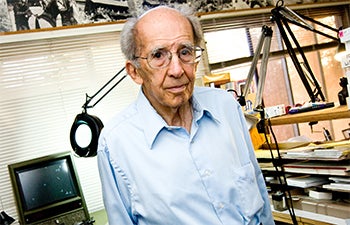No Longer ‘Forgotten Genocide’
In honor of the 100th anniversary of the Armenian Genocide, the USC Shoah Foundation – The Institute for Visual History and Education is preparing at least 40 of the nearly 400 Armenian testimonies it has secured from the Armenian Film Foundation for its Visual History Archive.
Based in USC Dornsife, the USC Shoah Foundation signed an agreement in April 2010 with the Armenian Film Foundation to digitize the interviews of the late J. Michael Hagopian, recorded on film between 1972 and 2005. The entire collection is expected to be integrated with the archive by the fall.
An Armenian Genocide survivor, Hagopian was an award-winning filmmaker who made 70 educational films and documentaries including 17 films about Armenians and the Armenian Genocide. Carried out during and after World War I, the genocide resulted in the killing of approximately 1.5 million people.
“This project will unveil a trove of film testimony about of a horrific chapter of human history that remains woefully under-examined,” said Karen Jungblut, director of research and documentation at the institute.
The interviews include not only survivors of the Armenian Genocide but also of other groups targeted by the Ottoman Turks, such as the Greeks, Assyrians and Yezidis. Also included are non-victim witnesses to the atrocities, such as Christian missionaries and Arab villagers, as well as descendants of the survivors and several renowned scholars.

The USC Shoah Foundation Institute is digitizing interviews of the late J. Michael Hagopian seen here, an Armenian Genocide survivor who made films about the Armenian Genocide. Photo by Cynthia Fox courtesy of the Shoah Foundation Institute.
“The addition of these interviews to the Visual History Archive will provide broad access to a multilingual collection of material,” said project adviser Richard G. Hovannisian, an expert in Armenian studies and USC Dornsife adjunct professor of history.
“It will help to bring sorely needed attention — and study — to this dark corner of human understanding,” said Hovannisian, a UCLA professor emeritus.
The interviews display a unique style and format, as they were conducted by a documentary filmmaker. A clapboard marks the start of each take. The interviews — about 15 minutes each — are much shorter than other testimonies in the Visual History Archive, which average more than two hours. Hagopian can be heard giving directions to crew members and interview subjects.
“Michael Hagopian generously gave us full access to his film dailies, which is akin to a diary in that they normally wouldn’t be seen by the public,” said Hrag Yedalian, a program coordinator with the institute. “This lends a certain candor to these interviews, which are at times unsettling to watch, but poignant.”
The foundation has released two advance clips of the Armenian testimonies. One is a 1987 talk with Mihran Andonian, who was a boy when his family was deported from Isparta in western Turkey in 1916 and lost eight family members. The other is a 1993 interview with Haroutune Aivazian, who tells of surviving because his mother left him at an orphanage.
“Even those of us who did survive, we lost something very precious,” Aivazian said. “Something which is the birthright of every person: childhood. We lost our childhood.”
The testimonies served as primary source material for Hagopian’s documentaries about the Armenian Genocide, including The Forgotten Genocide, recipient of two Emmy nominations in 1976, and the Witnesses Trilogy: Voices from the Lake, Germany and the Secret Genocide and The River Ran Red.
“He understood the importance of recording the testimonies of aging eyewitnesses before their accounts were lost forever,” said Carla Garapedian of the Armenian Film Foundation. “The voices of the people haunted by these atrocities will now be accessible to teachers, students, scholars and the general public on a global scale.”